Click an image to view the transformative results experienced by real BIMZELX patients.
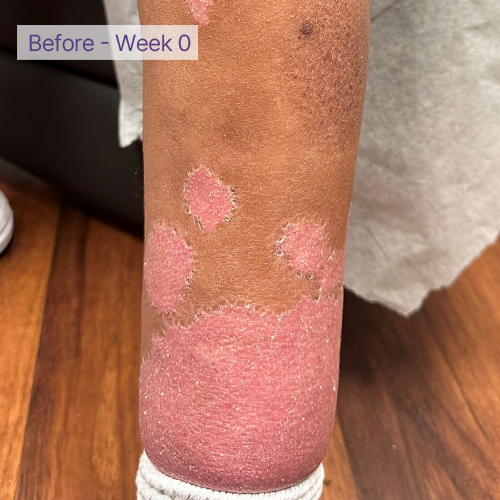
In clinical studies, up to 19% of patients achieved PASI 100 at Week 4*

In clinical studies, up to 68% of trial participants achieved PASI 100 at Week 16*
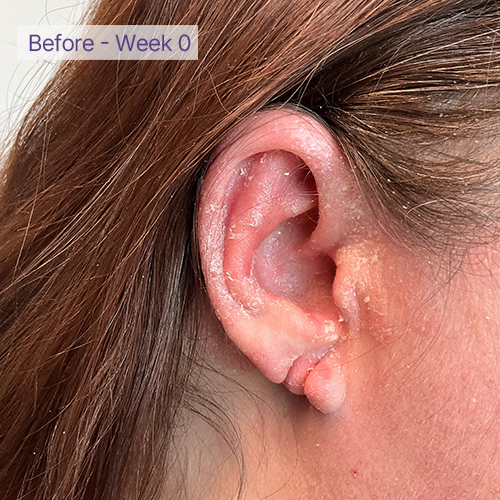
In clinical studies, up to 45% of patients achieved PASI 90 at Week 4*

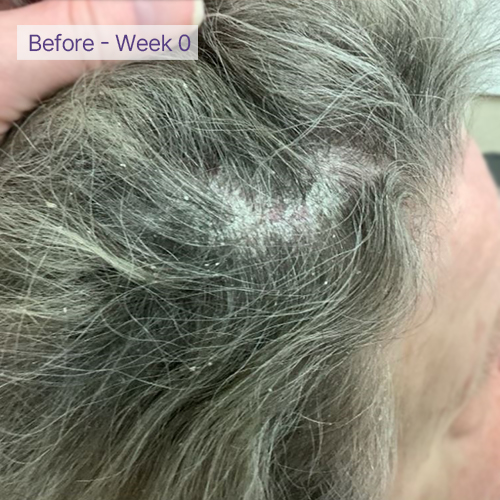

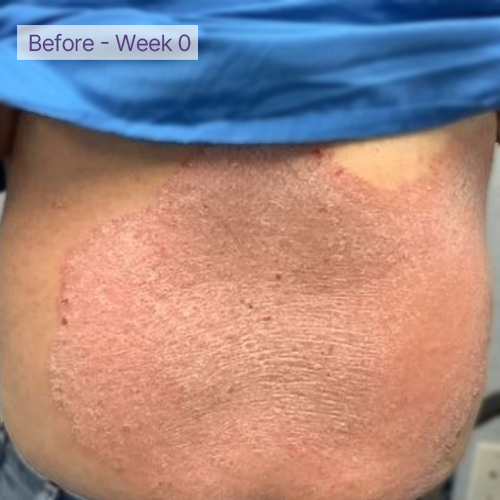


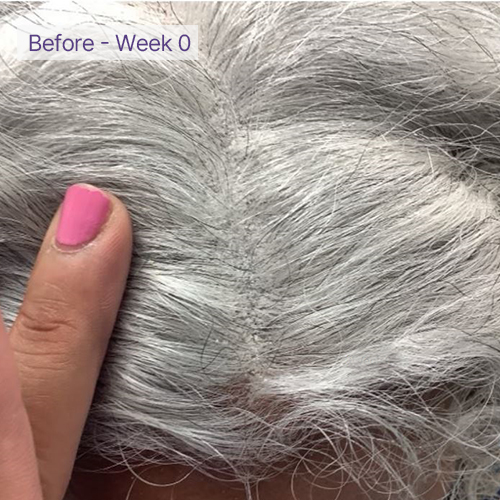
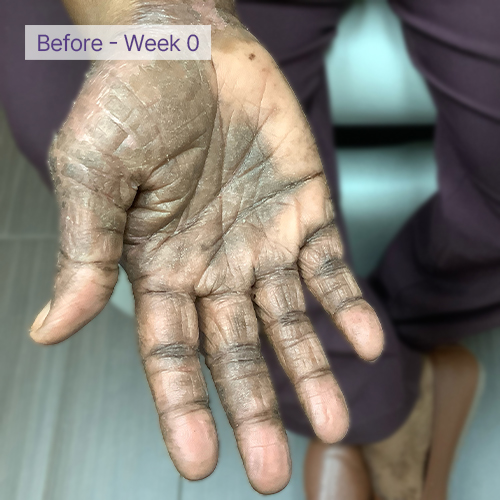
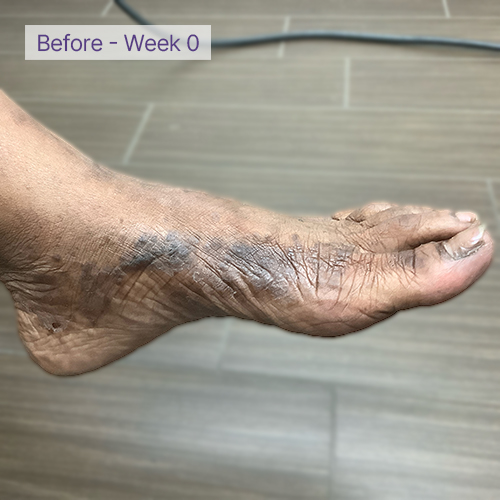

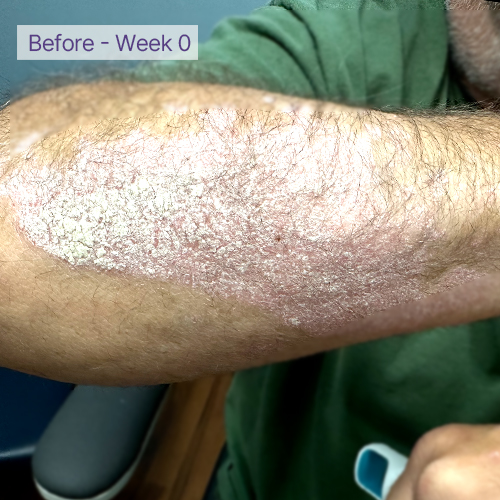
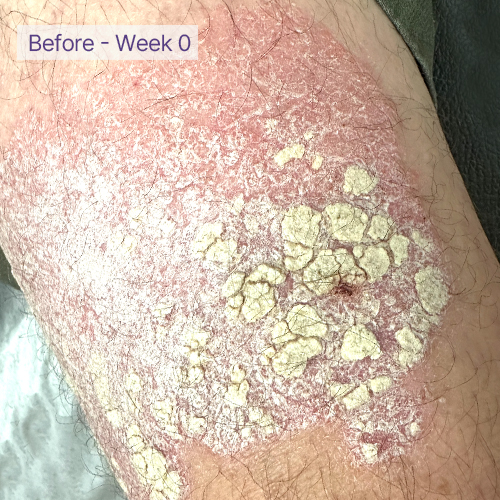
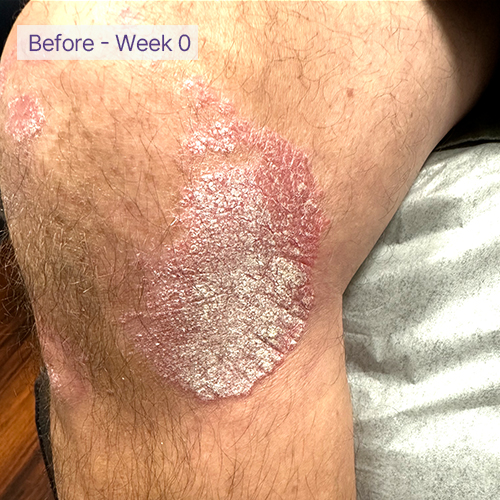
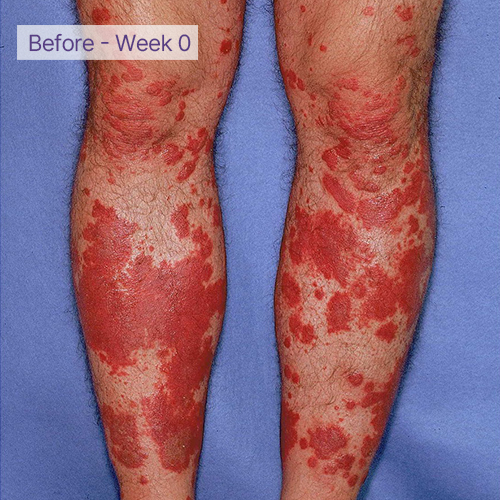

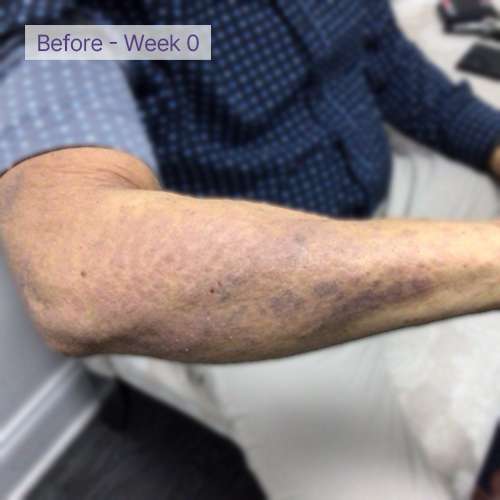
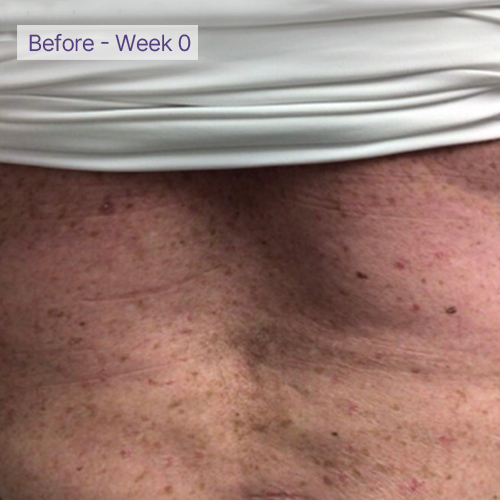
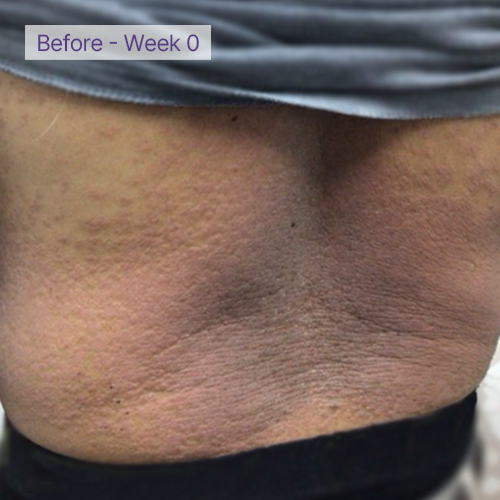

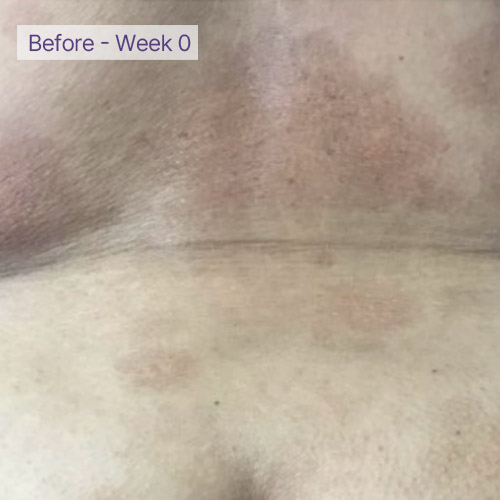
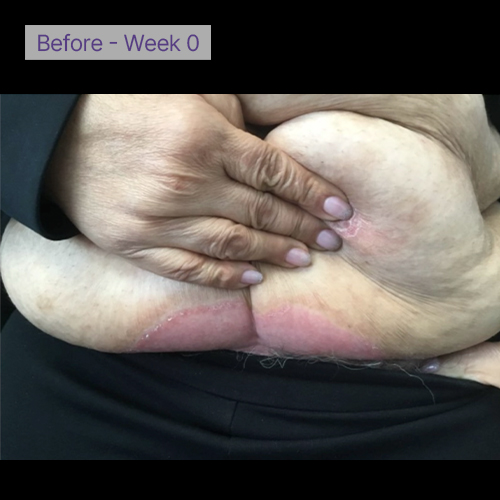

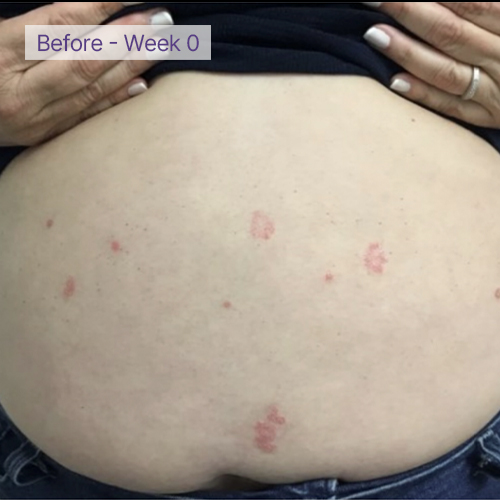
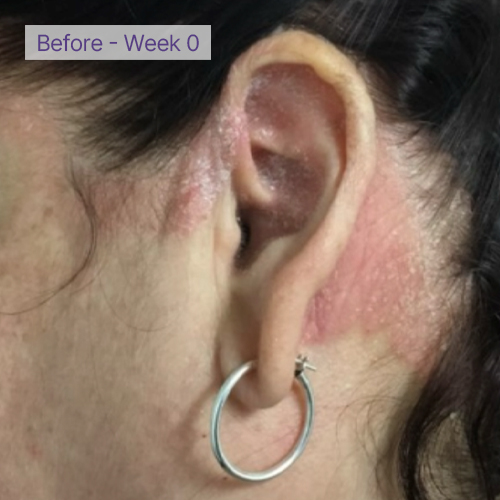

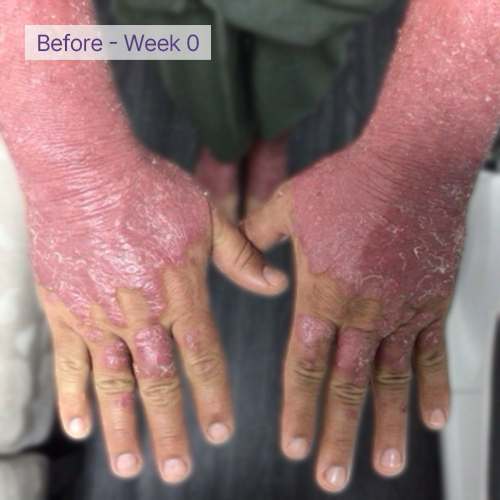
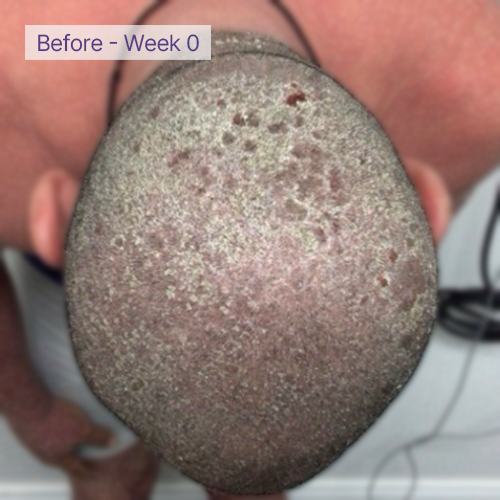
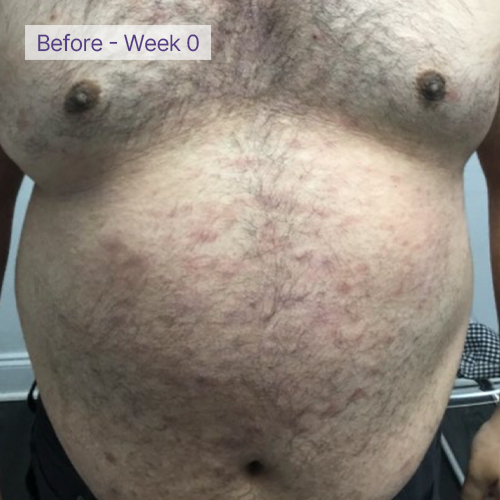
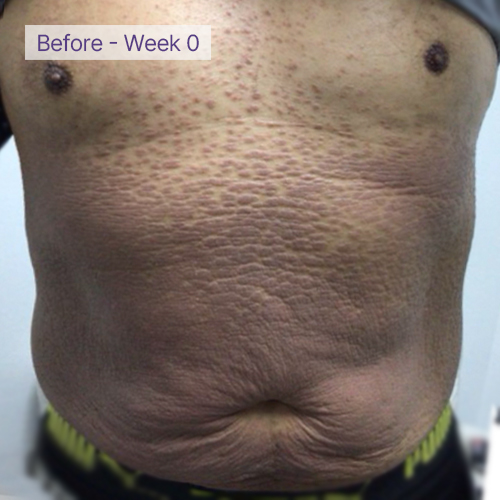
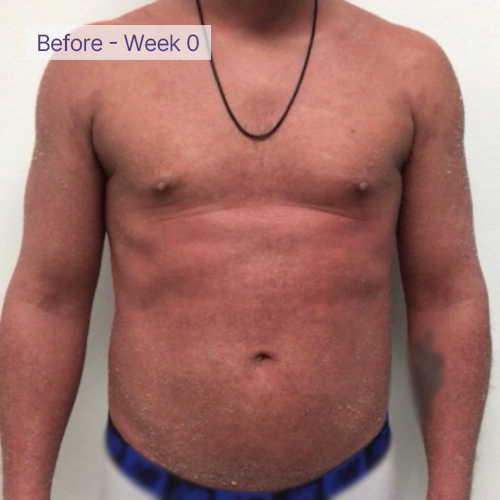
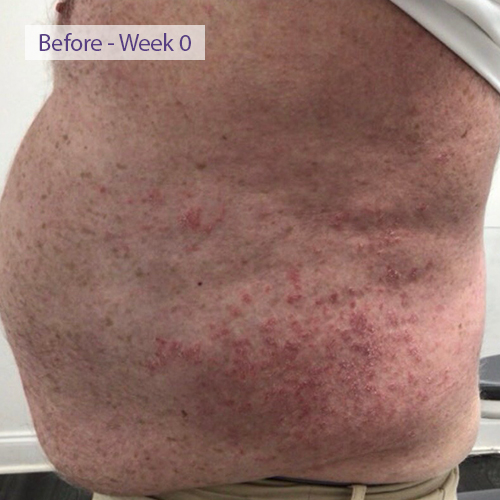
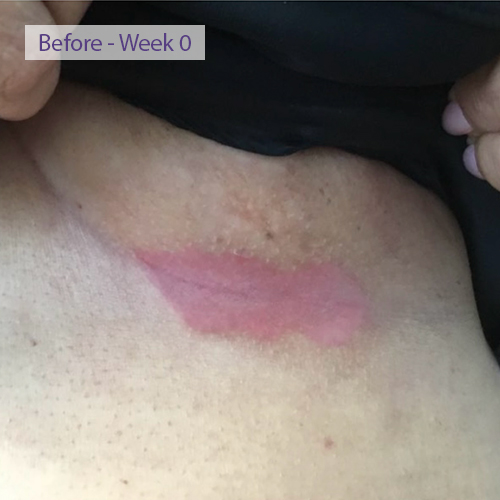
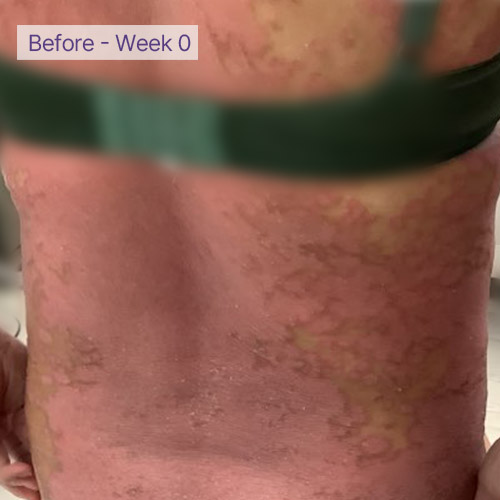
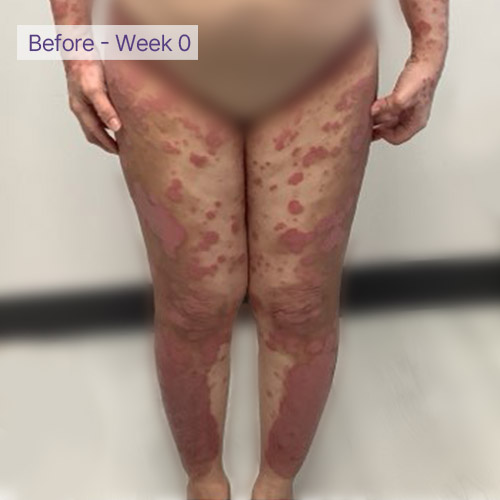

*Results demonstrated in the BE READY trial.
BE READY1,2,6
Co-primary endpoints:
PASI 90 at Week 16: 91% (BIMZELX), 1% (placebo)—(P<0.0001)
IGA 0/1 at Week 16: 93% (BIMZELX), 1% (placebo)—(P<0.0001)
Pre-specified secondary endpoint:
PASI 100 at Week 16: 68% (BIMZELX), 1% (placebo)—(P<0.0001)
Other endpoint:
PASI 100 at Week 4: 19% (BIMZELX), 0% (placebo)—(endpoint not adjusted for multiplicity. Nominal P value)
BE VIVID1,4,6
Co-primary endpoints:
PASI 90 at Week 16: 85% (BIMZELX), 5% (placebo)—(P<0.0001)
IGA 0/1 at Week 16: 84% (BIMZELX), 5% (placebo)—(P<0.0001)
Pre-specified secondary endpoint:
PASI 100 at Week 16: 59% (BIMZELX), 0% (placebo)—(P<0.0001)
Other endpoint:
PASI 100 at Week 4: 15% (BIMZELX), 1% (placebo)—(endpoint not adjusted for multiplicity. Nominal P value)
BE RADIANT3,6
Primary endpoint:
PASI 100 at Week 16: 62% (BIMZELX), 49% (secukinumab)—(P<0.001)
Other endpoint:
PASI 100 at Week 4: 14% (BIMZELX), 6% (secukinumab)—(endpoint not adjusted for multiplicity. Nominal P value)
BE SURE5,6
Co-primary endpoints:
PASI 90 at Week 16: 86% (BIMZELX), 47% (adalimumab)—(P<0.001)
IGA 0/1 at Week 16: 85% (BIMZELX), 57% (adalimumab)—(P<0.001)
Pre-specified secondary endpoint:
PASI 100 at Week 16: 61% (BIMZELX), 24% (adalimumab)—(P<0.001)
Other endpoint:
PASI 100 at Week 4: 15% (BIMZELX), ~1% (adalimumab)—(endpoint not adjusted for multiplicity. Nominal P value)
The Only IL-17 With Dosing Every 8 Weeks1,7,8

The recommended dose of BIMZELX for adult patients with moderate-to-severe plaque psoriasis is 320 mg
at Weeks 0, 4, 8, 12, and 16, then every 8 weeks thereafter.
For patients weighing ≥120 kg, a dose of 320 mg every 4 weeks after Week 16 may be considered.1
| Year 1 (includes initiation) | Yearly (maintenance) | |
|---|---|---|
| BIMZELX1 | 9 doses | 6 doses* |
| COSENTYX® (secukinumab)7 | 16 doses | 13 doses |
| TALTZ® (ixekizumab)8 | 16 doses | 13 doses |
*7 doses every other year.
IL=interleukin.
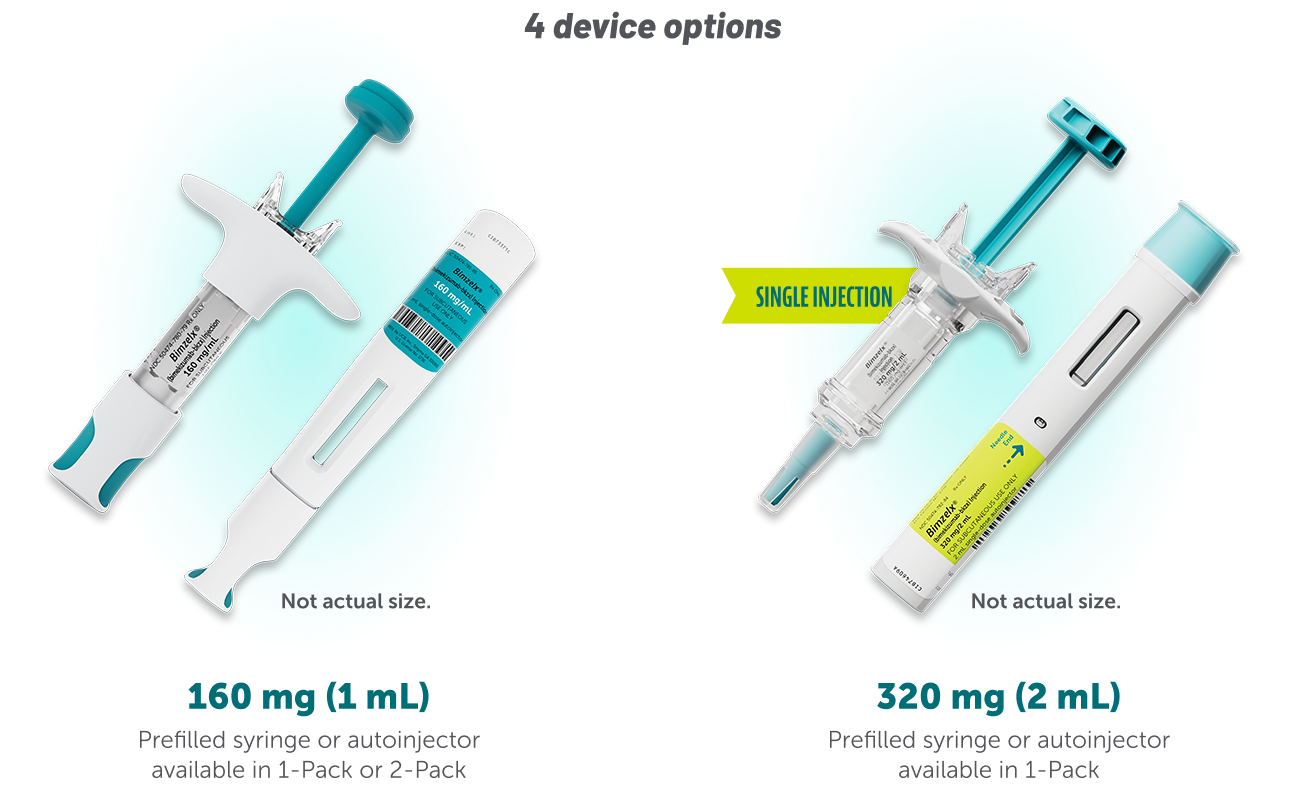
Safety Profile
| Most common adverse drug reactions occurring in greater than 1% of subjects on BIMZELX through Week 16 in placebo-controlled studies (BE VIVID and BE READY)1 | ||
|---|---|---|
| BIMZELX 320 mg Q4W (n=670) n(%) | Placebo (n=169) n(%) | |
| URI* | 102(15) | 24(14) |
| Oral candidiasis† | 61(9) | 0(0) |
| Headache | 22(3) | 0(0) |
| Injection site reactions‡ | 19(3) | 2(1) |
| Tinea infections§ | 18(3) | 1(1) |
| Gastroenteritis|| | 12(2) | 0(0) |
| Herpes simplex infections¶ | 9(1) | 0(0) |
| Acne | 8(1) | 0(0) |
| Folliculitis | 8(1) | 0(0) |
| Other candida infections# | 7(1) | 1(1) |
| Fatigue | 7(1) | 0(0) |
| * | Upper respiratory infections include nasopharyngitis, upper respiratory tract infection, pharyngitis, rhinitis, viral upper body respiratory tract infection, tonsillitis, sinusitis, pharyngitis streptococcal, pharyngitis bacterial, peritonsillar abscess, viral rhinitis, and influenza. |
† | Oral candidiasis includes oral candidiasis, oropharyngeal candidiasis, oral fungal infection, fungal pharyngitis, and oropharyngitis fungal. |
‡ | Injection site reactions include injection site reaction, injection site erythema, injection site pain, injection site edema, injection site bruising, and injection site swelling. |
§ | Tinea infections include tinea pedis, fungal skin infection, tinea veriscolor, tinea cruris, tinea infection, body tinea, and onychomycosis. |
|| | Gastroenteritis includes Enterovirus infection, gastroenteritis, gastroenteritis bacterial, and gastroenteritis viral. |
¶ | Herpes simplex infections include herpes simplex and oral herpes. |
| # | Other candida infections include vulvovaginal candidiasis, vulvovaginal mycotic infection, skin candida, and genital candidiasis. Q4W=every 4 weeks; URI=upper respiratory infection. |
In BIMZELX clinical studies, the vast majority of oral candidiasis cases:
• Were mild to moderate9
• Resolved with standard therapy9
For additional safety information, including long-term safety data, please visit BIMZELXhcp.com/safety.
BE READY: BIMZELX VS PLACEBO1,2
Trial Design: a pivotal, phase 3, multicenter, randomized, placebo-controlled, double-blind trial comparing BIMZELX vs placebo. Co-primary endpoints were the proportion of BIMZELX patients achieving PASI 90 and the proportion of patients achieving an IGA score of 0/1 at Week 16 vs placebo. Efficacy computed using NRI.
BE VIVID: BIMZELX VS PLACEBO AND STELARA®1,4
Trial Design: a pivotal, phase 3, multicenter, randomized, placebo-controlled, double-blind trial comparing BIMZELX vs placebo and STELARA (45 mg or 90 mg [baseline weight-dependent dosing] at Week 0 and 4, then every 12 weeks). Co-primary endpoints were the proportion of BIMZELX patients achieving PASI 90 and the proportion of patients with an IGA score of 0/1 at Week 16 vs placebo. Efficacy computed using NRI.
BE RADIANT: BIMZELX VS COSENTYX®3
Trial Design: a phase 3b, randomized, double-blind, active comparator-controlled study comparing BIMZELX vs COSENTYX (300 mg weekly to Week 4, followed by every 4 weeks to Week 48). The primary endpoint was the percentage of BIMZELX patients achieving PASI 100 at Week 16 vs COSENTYX. Ranked secondary endpoints included the proportion of patients achieving PASI 75 at Week 4. Efficacy computed using NRI.
BE SURE: BIMZELX VS HUMIRA®5
Trial Design: a pivotal, 56-week, phase 3, double-blind, randomized, active comparator-controlled trial comparing BIMZELX vs HUMIRA (40 mg every 2 weeks for 24 weeks). Co-primary endpoints were the proportion of BIMZELX patients achieving PASI 90 and the proportion of patients with an IGA score of 0/1 at Week 16 vs HUMIRA. The five ranked secondary efficacy endpoints were a PASI 100 response at Week 16, a PASI 75 response at Week 4, a PASI 100 response at Week 24, a PASI 90 response at Week 24, and an IGA score of 0/1 at Week 24. Efficacy computed using NRI.
Important Safety Information
Suicidal Ideation and Behavior
BIMZELX® (bimekizumab-bkzx) may increase the risk of suicidal ideation and behavior (SI/B). A causal association between treatment with BIMZELX and increased risk of SI/B has not been definitively established. Prescribers should weigh the potential risks and benefits before using BIMZELX in patients with a history of severe depression or SI/B. Advise monitoring for the emergence or worsening of depression, suicidal ideation, or other mood changes. If such changes occur, instruct to promptly seek medical attention, refer to a mental health professional as appropriate, and re-evaluate the risks and benefits of continuing treatment.
Infections
BIMZELX may increase the risk of infections, including serious infections. Do not initiate treatment with BIMZELX in patients with any clinically important active infection until the infection resolves or is adequately treated. In patients with a chronic infection or a history of recurrent infection, consider the risks and benefits prior to prescribing BIMZELX. Instruct patients to seek medical advice if signs or symptoms suggestive of clinically important infection occur. If a patient develops such an infection or is not responding to standard therapy, monitor the patient closely and do not administer BIMZELX until the infection resolves.
Tuberculosis
Evaluate patients for tuberculosis (TB) infection prior to initiating treatment with BIMZELX. Avoid the use of BIMZELX in patients with active TB infection. Initiate treatment of latent TB prior to administering BIMZELX. Consider anti-TB therapy prior to initiation of BIMZELX in patients with a past history of latent or active TB in whom an adequate course of treatment cannot be confirmed. Closely monitor patients for signs and symptoms of active TB during and after treatment.
Liver Biochemical Abnormalities
Elevated serum transaminases were reported in clinical trials with BIMZELX. Test liver enzymes, alkaline phosphatase and bilirubin at baseline, periodically during treatment with BIMZELX and according to routine patient management. If treatment-related increases in liver enzymes occur and drug-induced liver injury is suspected, interrupt BIMZELX until a diagnosis of liver injury is excluded. Permanently discontinue use of BIMZELX in patients with causally associated combined elevations of transaminases and bilirubin. Avoid use of BIMZELX in patients with acute liver disease or cirrhosis.
Inflammatory Bowel Disease
Cases of inflammatory bowel disease (IBD) have been reported in patients treated with IL-17 inhibitors, including BIMZELX. Avoid use of BIMZELX in patients with active IBD. During BIMZELX treatment, monitor patients for signs and symptoms of IBD and discontinue treatment if new onset or worsening of signs and symptoms occurs.
Immunizations
Prior to initiating therapy with BIMZELX, complete all age-appropriate vaccinations according to current immunization guidelines. Avoid the use of live vaccines in patients treated with BIMZELX.
MOST COMMON ADVERSE REACTIONS
Most common (≥1%) adverse reactions in plaque psoriasis and hidradenitis suppurativa include upper respiratory tract infections, oral candidiasis, headache, injection site reactions, tinea infections, gastroenteritis, herpes simplex infections, acne, folliculitis, other candida infections, and fatigue.
If your patient has experienced an adverse event (side effect) or product quality complaint with a UCB product, please contact UCBCares® at 1-844-599-CARE (2273) or email ucbcares@ucb.com.
References:
1. BIMZELX [prescribing information]. Smyrna, GA: UCB, Inc. 2. Gordon KB, et al. Lancet. 2021;397(10273):475-486. 3. Reich K, et al. N Engl J Med. 2021;385(2):142-152.
4. Reich K, et al. Lancet. 2021;397(10273):487-498. 5. Warren RB, et al. N Engl J Med. 2021;385(2):130-141. 6. Data on file. UCB, Inc.; Smyrna, GA. 7. COSENTYX® [prescribing information]. East Hanover, NJ: Novartis Pharmaceuticals Corp. 8. TALTZ® [prescribing information]. Indianapolis, IN: Eli Lilly and Company. 9. Gordon KB, et al. JAMA Dermatol. 2022;158(7):735-744.

